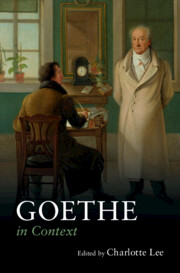Book contents
- Goethe in Context
- Goethe in Context
- Copyright page
- Contents
- Illustrations
- Notes on Contributors
- Acknowledgements
- Note on Translations and List of Abbreviations
- Chronology
- Introduction
- Part I Life and Times
- Chapter 1 The Life
- Chapter 2 Frankfurt and Weimar
- Chapter 3 Weimar Court and Society
- Chapter 4 Goethe as Civil Servant
- Chapter 5 Class
- Chapter 6 The French Revolution
- Chapter 7 Religion
- Part II Literature
- Part III Art
- Part IV Philosophy and Science
- Part V World Cultures Inspiration and Reception
- Part VI Goethe’s Lasting Significance
- Further Reading
- Index
Chapter 3 - Weimar Court and Society
from Part I - Life and Times
Published online by Cambridge University Press: 16 May 2024
- Goethe in Context
- Goethe in Context
- Copyright page
- Contents
- Illustrations
- Notes on Contributors
- Acknowledgements
- Note on Translations and List of Abbreviations
- Chronology
- Introduction
- Part I Life and Times
- Chapter 1 The Life
- Chapter 2 Frankfurt and Weimar
- Chapter 3 Weimar Court and Society
- Chapter 4 Goethe as Civil Servant
- Chapter 5 Class
- Chapter 6 The French Revolution
- Chapter 7 Religion
- Part II Literature
- Part III Art
- Part IV Philosophy and Science
- Part V World Cultures Inspiration and Reception
- Part VI Goethe’s Lasting Significance
- Further Reading
- Index
Summary
Chapter 3 explains the development of the court and society of Weimar, from the strategic decisions taken by Anna Amalia during her regency to the influence of her son, Carl August. The chapter considers the different forms of sociability that were cultivated, alongside the roles of particular institutions in the life of Weimar, above all the theatre and the university at nearby Jena. It addresses the paradox of a society that was at once conservative and progressive, a tension which was also reflected in Goethe’s own career in the town.
- Type
- Chapter
- Information
- Goethe in Context , pp. 30 - 38Publisher: Cambridge University PressPrint publication year: 2024

